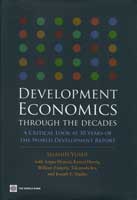Development Economics through the Decades. A critical look at 30 years of the World Development Report, by Shahid Yusuf. The World Bank Publications, 2009.
A review by Marco Zupi.

Since its first publication in 1978, the World Bank’s annual World Development Report (WDR) has become a high-ranking publication, probably the most influential in setting the agenda for development cooperation studies and strategies. Inspired by its success, other organizations began publishing annual report series intended to serve as leading intellectual and political references, such as the United Nations Development Programme’s (UNDP’s) Human Development Report and the United Nations Conference on Trade and Development’s (UNCTAD’s) World Investment Report. Development Economics through the Decades by Shahid Yusuf, economic adviser at the World Bank and director of the WDR 1999/2000, marks the WDR’s 30th anniversary and is recommended reading to all those interested in the evolution of development economics over the past three decades.
Yusuf’s succinct and well-written examination of the last 30 years of development economics begins by summarizing some of the main trends that emerged in the 1950s and 1960s. It then provides a rich examination of the WDRs and their key development themes over 30 years: agriculture, poverty, economic growth, infrastructure, the investment climate and the environment. Yusuf also looks at key challenges that future WDRs might explore, such as climate change coupled with resource and energy scarcities, the geography of human habitation, resilient complex societies and the need for multidisciplinary approaches. Five distinguished economists – Angus Deaton, Kemal Dervis, William Easterly, Takatoshi Ito and Joseph Stiglitz – then comment on Yusuf’s reflections in separate essays.
This book offers a valuable and compact tour of mainstream development economics, complete with references. However, a couple of critical remarks have to be made.First of all, it does not fulfil its promise of providing a ‘critical look’. Instead, it provides an elegant illustration of the risks that critical reviews of development take if they fail to reflect on their assumptions and the fact that they are part of hegemonic discursive formation. What we mean to say is that the categories used in development studies and policies are not given a priori. They are fabricated, and as such they are active producers of meaning, knowledge and identity. This essentially political activity is evident in the discourse articulated by the WDRs. But Yusuf does not acknowledge this. He suggests that the WDRs merely reflect the changing or progressing views at the World Bank, such as the shift from structural change and capital accumulation in the 1970s, the neoliberal views of the 1980s, the consensus of the 1990s (complementary of state and markets) and finally today’s institutional economics (or the need to build quality institutions for markets to work properly). He does not explain that this is effectively a political, value and interest-based history of ideas and practices.
The WDRs, as other mainstream development economics and cooperation policies, have always presented and translated ‘innovative’ ideas in terms of cumulative approaches to development, rather than as a shift of paradigms. The juxtaposition of different approaches and priorities (the neo-liberal market-friendly macroeconomic policy framework for ‘getting prices right’, the focus on political and good governance reforms, the general objective of ‘putting poverty first’ and promoting social development, as well as more recent global security concerns) have caused competing, confused and contradictory focuses and actions. However, Yusuf is himself aligned to the mainstream discourse on development economics, and does not explore the power of ideas and the controversies implied in competing paradigms.
As Dani Rodrik of Harvard University argues in his last book, One Economics, Many Recipes, Princeton University Press, (2007) there is need for a critical response to the international ‘consensus’ approach to economic policy-making with its implicit assumption that one set of policies is suitable for all, or at least most, countries. Unfortunately this response, which would include a reflection on the limits of conventional economics, has not been developed by Yusuf or the five commentators.
What goes unmentioned is the fact that, despite the rhetoric, an enormous gap remains between the World Bank’s strategic vision and its operational practice. This starts with the discrepancy between the priority of fighting poverty and the operational portfolio of actions and also includes the mismatch between some of the ‘thinkers’ and the policy makers at the Bank. The question of whether and how the WDR ideas and theories have been translated into actions and strategies goes unanswered.
The book does not consider the global economic and financial crisis that exploded in July 2007. This crisis challenges the core principles of today’s economic orthodoxy, adopted by the World Bank and the WDRs, among others. It shows that financial markets do not obey the efficient market principles described in economic textbooks, but are instead inherently unstable and habitually crisis-prone. The proven weaknesses of orthodox assumptions and the tragedy of persistent chronic poverty in most of the poor countries targeted by the World Bank should have been seized as the perfect occasion to discuss and reconsider the substantive significance of many of the ideas contained in the WDRs.
To sum up, considering 30 years of thinking on development economics is by definition a difficult but interesting exercise. If you want to learn about WDRs and mainstream approaches as they have evolved until now, you want to read this book.
